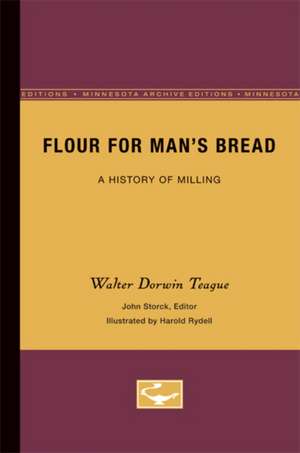Flour for Man’s Bread: A History of Milling
Editat de John Storck Autor Walter Dorwin Teague Ilustrat de Harold Rydellen Limba Engleză Paperback – 1952
Flour for Man's Bread was first published in 1952. Minnesota Archive Editions uses digital technology to make long-unavailable books once again accessible, and are published unaltered from the original University of Minnesota Press editions.
From prehistoric times to the present, the ways in which man has made flour for his bread have forged the patterns of technological progress and have greatly influenced his social development. This book describes in detail how people of the western world have ground their grain - by hand, by animal-driven wheels, by crude water-powered mills, and, finally, by complex engineering methods. The story of milling provides a graphic history of man's ingenuity in the mechanical arts, his harnessing of power sources, and his development of agricultural skill.
While the central theme is the improvement of technical processes, this development is presented, not in a vacuum, but in the context of economic geography and social history. Thus the volume offers much of importance to students of social economic history, archaeology, anthropology, sociology, agriculture, and general technology, as well as those with a specific interest in milling methods.
The book brings to readers some of the advantages of what was originally projected as a museum of flour milling several years ago by General Mills. Walter Dorwin Teague, the noted industrial designer, drew plans for the museum and arranged for the fundamental research, which was carried out by Dr. John Storck, anthropologist and former professor at Columbia University and Sarah Lawrence College. Hundreds of detailed drawings illustrating the processes and devices described were prepared under their direction. Although plans for the museum had to be abandoned, the extensive research and excellent illustrative material are now made available in this comprehensive, single volume history of milling and its social and economic implications.
From prehistoric times to the present, the ways in which man has made flour for his bread have forged the patterns of technological progress and have greatly influenced his social development. This book describes in detail how people of the western world have ground their grain - by hand, by animal-driven wheels, by crude water-powered mills, and, finally, by complex engineering methods. The story of milling provides a graphic history of man's ingenuity in the mechanical arts, his harnessing of power sources, and his development of agricultural skill.
While the central theme is the improvement of technical processes, this development is presented, not in a vacuum, but in the context of economic geography and social history. Thus the volume offers much of importance to students of social economic history, archaeology, anthropology, sociology, agriculture, and general technology, as well as those with a specific interest in milling methods.
The book brings to readers some of the advantages of what was originally projected as a museum of flour milling several years ago by General Mills. Walter Dorwin Teague, the noted industrial designer, drew plans for the museum and arranged for the fundamental research, which was carried out by Dr. John Storck, anthropologist and former professor at Columbia University and Sarah Lawrence College. Hundreds of detailed drawings illustrating the processes and devices described were prepared under their direction. Although plans for the museum had to be abandoned, the extensive research and excellent illustrative material are now made available in this comprehensive, single volume history of milling and its social and economic implications.
Preț: 477.23 lei
Nou
Puncte Express: 716
Preț estimativ în valută:
91.32€ • 95.54$ • 75.86£
91.32€ • 95.54$ • 75.86£
Carte tipărită la comandă
Livrare economică 02-16 aprilie
Preluare comenzi: 021 569.72.76
Specificații
ISBN-13: 9780816658787
ISBN-10: 0816658781
Pagini: 400
Dimensiuni: 152 x 229 x 15 mm
Greutate: 0.69 kg
Ediția:Minnesota Archi
Editura: University of Minnesota Press
Colecția Univ Of Minnesota Press
ISBN-10: 0816658781
Pagini: 400
Dimensiuni: 152 x 229 x 15 mm
Greutate: 0.69 kg
Ediția:Minnesota Archi
Editura: University of Minnesota Press
Colecția Univ Of Minnesota Press
Notă biografică
Walter Dorwin Teague was born in 1883 in Indiana. He studied for five years at the Art Students League in New York. Though trained as a graphic designer, Teague went on to become a successful industrial designer, eventually designing an automobile with hi
Textul de pe ultima copertă
Minnesota Archive Editions uses digital technology to make long-unavailable books once again accessible to scholars, students, researchers, and general readers. Rich with historical and cultural value, these works are published unaltered from the original University of Minnesota Press editions. The books offered through Minnesota Archive Editions are produced in limited quantities according to customer demand and are available through select distribution partners.
